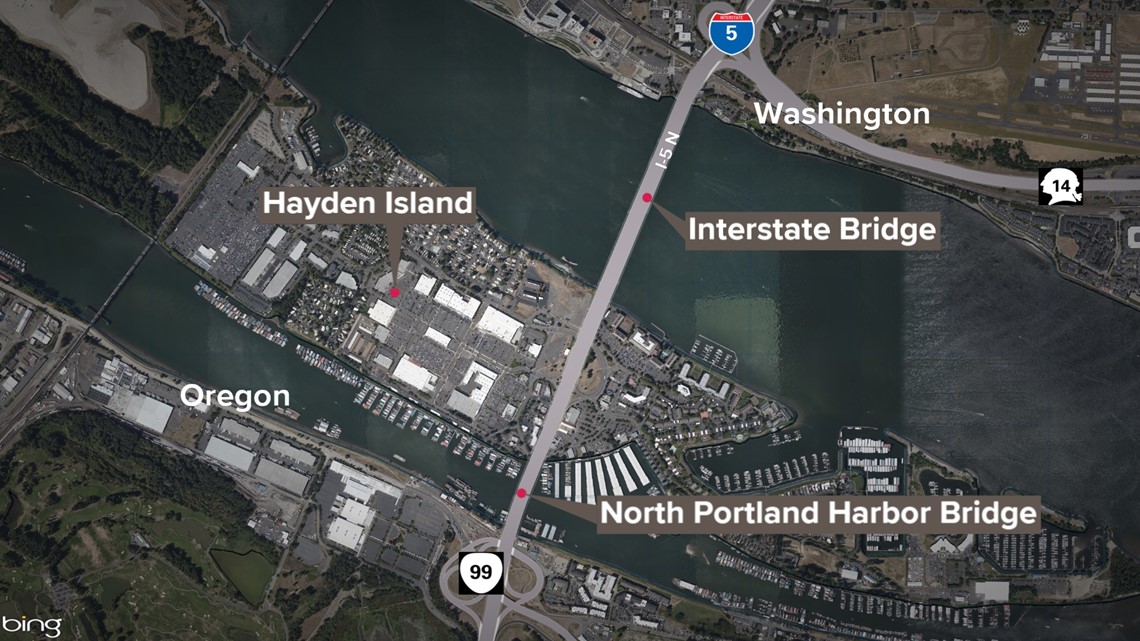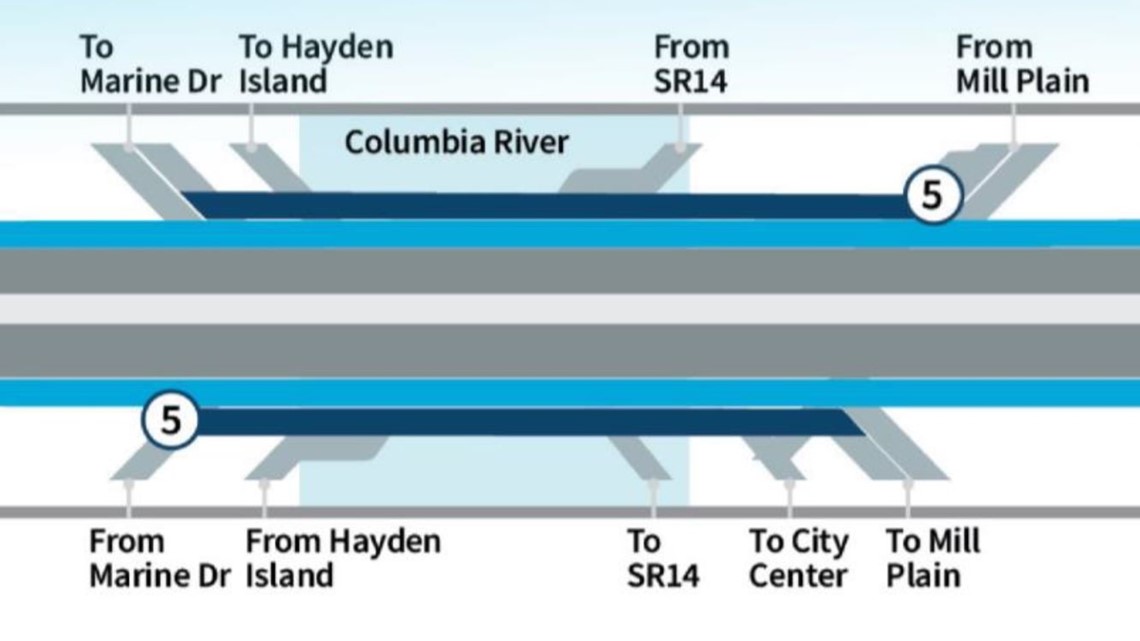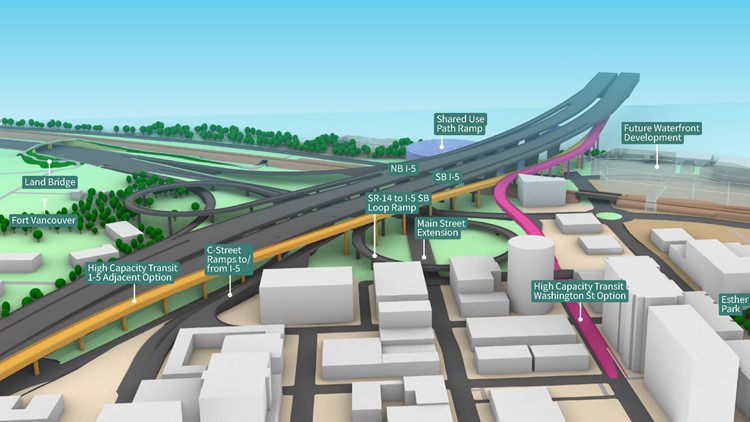VANCOUVER, Wash. — The Interstate Bridge Replacement (IBR) Program is about to fill in most of the remaining conceptual details about the proposed replacement for the bridge that carries Interstate 5 over the Columbia River. The project office is scheduled to unveil its recommended Locally Preferred Alternative (LPA) later this week.
Some of the team’s recommendations are already known, such as the inclusion of light rail, but several other design choices won’t be finalized until a Thursday meeting of the project’s Executive Steering Group, followed by a Friday meeting of the Bi-State Legislative Committee that oversees the program.
Here’s a breakdown of what we already know about the new bridge design, what we’re probably going to learn from the LPA on Thursday, and what we’re probably still not going to know at the end of the week.
What we already know
High-capacity transit mode: Light rail
The IBR team evaluated two mass transit options: Light rail and Bus Rapid Transit (BRT). The team announced last month that it will recommend light rail due to higher projected ridership because it would allow for direct transfers from C-Tran bus lines in downtown Vancouver.
High-capacity transit alignment: I-5 adjacent
The previous replacement attempt, the failed Columbia River Crossing (CRC), called for light rail to run on Vancouver’s downtown streets, ending at Clark College. The IBR team chose to scale back that recommendation, keeping the line adjacent to I-5 and ending it at Evergreen Boulevard, because C-Tran’s Vine Bus Rapid Transit line now runs through downtown Vancouver.


Bridge alignment: West
The old bridge must remain in use until the new bridge is ready, which means the new one will need to be built to the east or west of the existing structure. The IBR team has selected a western alignment as its recommendation, according to a spokesperson.
North Portland Harbor Bridge: Replacement
The project team is recommending a full replacement of the North Portland Harbor Bridge, which carries I-5 from the Oregon mainland to Hayden Island. The CRC plan called for modifying and maintaining the current bridge, but the IBR team cited the additional 10 years of wear and tear, coupled with the need for better seismic resiliency, to justify the switch to a full replacement.


What we’re about to learn
Bridge crossing configuration: Twin or stacked?
Back in January the project team outlined two options for the bridge layout: twin spans that each carry one direction of the freeway or a single span with one deck stacked on top of the other. The twin span version would also have some stacking – concept art shows each span with a narrow second deck below the main deck to carry mass transit and bike and pedestrian traffic.
How many lanes: Eight or ten?
The current twin spans carry three lanes in each direction. The IBR project is exploring “auxiliary lanes,” which are right-side lanes that join the freeway for limited distances, usually to connect two interchanges so drivers can hop from one to the other without having to merge.
The IBR team’s LPA recommendation is definitely going to include auxiliary lanes, but the team is still deciding whether to add one lane on each side or two, which would bring the bridge’s total width from six lanes to either eight or ten, not counting shoulders and transit lanes.


Hayden Island: Full or partial interchange?
I-5 currently has a full interchange on Hayden Island, and the IBR team is deciding whether to keep it that way or reduce it to a partial interchange with only an entrance ramp for northbound traffic and an exit ramp for southbound traffic.
In this scenario, drivers traveling between Hayden Island and Portland would enter and exit the freeway at the Marine Drive interchange on the Oregon mainland and cross to and from Hayden Island on a separate arterial bridge.
The auxiliary lanes and the Hayden Island interchange options are linked. The project office revealed last month that it had narrowed things down to two scenarios – one with a single set of auxiliary lanes and a partial interchange, and the other with two sets of auxiliary lanes and a full interchange.


What we still won’t know
Total project cost
The IBR office has pegged the project cost at $3.2 billion to $4.8 billion, but that’s an early and rough estimate. A more precise breakdown won’t be available until the project is much further into the design process, although that didn’t stop Washington from allocating $1 billion earlier this year.
Tolling amount
There will almost certainly be tolls on the new bridge, and the Oregon Department of Transportation will collect them. What we don’t know is how much the tolls will cost or how they’ll integrate into ODOT’s plan to toll I-5 and I-205 throughout the Portland area. The IBR website only says that bridge tolls and I-5 tolls will be “coordinated” so drivers don’t receive multiple bills for the same trip.
Whether it can succeed
The CRC faced vociferous opposition from multiple groups, ultimately leading to its collapse. The IBR version has a long way to go before construction can begin, and many critics have made it clear that their objections still apply to the new project’s direction, including light rail opponents and environmental and transportation groups who oppose the addition of auxiliary lanes, which they argue would functionally make the replacement a freeway widening project.
With the full LPA revealed, Friday’s bi-state legislative committee meeting could be a significant early indicator about where the project stands in terms of political support.



